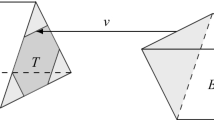Abstract
The problem of finding a best approximation pair of two sets, which in turn generalizes the well known convex feasibility problem, has a long history that dates back to work by Cheney and Goldstein in 1959. In 2018, Aharoni, Censor, and Jiang revisited this problem and proposed an algorithm that can be used when the two sets are finite intersections of halfspaces. Motivated by their work, we present alternative algorithms that utilize projection and proximity operators. Our modeling framework is able to accommodate even convex sets. Numerical experiments indicate that these methods are competitive and sometimes superior to the one proposed by Aharoni et al.







Similar content being viewed by others
References
Aharoni, R., Censor, Y., Jiang, Z.: Finding a best approximation pair of points for two polyhedra. Comput. Optim. Appl. 71, 509–523 (2018). https://doi.org/10.1007/s10589-018-0021-3
Bauschke, H.H.: The approximation of fixed points of compositions of nonexpansive mappings in Hilbert space. J. Math. Anal. Appl. 202, 150–159 (1996). https://doi.org/10.1006/jmaa.1996.0308
Bauschke, H.H., Borwein, J.M.: On the convergence of von Neumann’s alternating projection algorithm for two sets. Set-Valued Anal. 1, 185–212 (1993). https://doi.org/10.1007/BF01027691
Bauschke, H.H., Borwein, J.M.: Dykstra’s alternating projection algorithm for two sets. J. Approx. Theory 79, 418–443 (1994). https://doi.org/10.1006/jath.1994.1136
Bauschke, H.H., Combettes, P.L.: Convex Analysis and Monotone Operator Theory in Hilbert Spaces, 2nd edn. Springer, Berlin (2017). https://doi.org/10.1007/978-3-319-48311-5
Bauschke, H.H., Combettes, P.L., Luke, D.R.: Finding best approximation pairs relative to two closed convex sets in Hilbert spaces. J. Approx. Theory 127, 178–192 (2004). https://doi.org/10.1016/j.jat.2004.02.006
Bauschke, H.H., Moursi, W.M.: On the behavior of the Douglas–Rachford algorithm for minimizing a convex function subject to a linear constraint. SIAM J. Optim. 30, 2559–2576 (2020). https://doi.org/10.1137/19M1281538
Beck, A.: First-Order Methods in Optimization. SIAM, University City (2017). https://doi.org/10.1137/1.9781611974997
Beck, A., Teboulle, M.: A fast dual proximal-gradient algorithm for convex minimization and applications. Oper. Res. Lett. 42, 1–6 (2014). https://doi.org/10.1016/j.orl.2013.10.007
Bottou, L., Curtis, F.E., Nocedal, J.: Optimization methods for large-scale machine learning. SIAM Rev. 60, 223–311 (2018). https://doi.org/10.1137/16M1080173
Censor, Y.: Computational acceleration of projection algorithms for the linear best approximation problem. Linear Algebra Appl. 416, 111–123 (2006). https://doi.org/10.1016/j.laa.2005.10.006
Cheney, W., Goldstein, A.A.: Proximity maps for convex sets. Proc. AMS 10, 448–450 (1959). https://doi.org/10.2307/2032864
Combettes, P.L., Dũng, Đ, Vũ, B.C.: Dualization of signal recovery problems. Set-Valued Var. Anal. 18, 373–404 (2010). https://doi.org/10.1007/s11228-010-0147-7
Douglas, J., Rachford, H.H.: On the numerical solution of heat conduction problems in two and three space variables. Trans. AMS 82, 421–439 (1956). https://doi.org/10.1090/S0002-9947-1956-0084194-4
Halpern, B.: Fixed points of nonexpanding maps. Bull. Am. Math. Soc. 73, 957–961 (1967). https://doi.org/10.1090/S0002-9904-1967-11864-0
Keys, K.L., Zhou, H., Lange, K.: Proximal distance algorithms: theory and practice. J. Mach. Learn. Res. 20, 1–38 (2019)
Kiefer, J., Wolfowitz, J.: Stochastic estimation of the maximum of a regression function. Ann. Math. Stat. 23(3), 462–466 (1952). https://doi.org/10.1214/aoms/1177729392
Lange, K.: MM Optimization Algorithms. SIAM, University City (2016). https://doi.org/10.1137/1.9781611974409
Lange, K., Keys, K.L.: The proximal distance algorithm. In: Proceedings of the 2014 International Congress of Mathematicians, pp. 96–116. Seoul: Kyung Moon, 4. See also https://arxiv.org/abs/1507.07598
Lions, P.-L.: Approximation de points fixes de contractions. Comptes Rendus Hebdomadaires des Séances de l’Académie des Sciences Séries A (Sciences Mathématiques)) et B (Sciences Physiques) 284(21), 1357–1359 (June 6, 1977). https://gallica.bnf.fr/ark:/12148/bpt6k5731057m
Lions, P.-L., Mercier, B.: Splitting algorithms for the sum of two nonlinear operators. SIAM J. Numer. Anal. 16, 964–979 (1979). https://doi.org/10.1137/0716071
Robbins, H., Monro, S.: A stochastic approximation method. Ann. Math. Stat. 22(3), 400–407 (1951). https://doi.org/10.1214/aoms/1177729586
Wittmann, R.: Approximation of fixed points of nonexpansive mappings. Arch. Math. 58, 486–491 (1992). https://doi.org/10.1007/BF01190119
Acknowledgements
The authors thank the editor and the reviewers for helpful suggestions and constructive feedback which helped us to improve the presentation of the results, and Patrick Combettes for pointing out the relevant reference [13]. HHB and XW are supported by the Natural Sciences and Engineering Research Council of Canada.
Author information
Authors and Affiliations
Corresponding author
Additional information
Publisher's Note
Springer Nature remains neutral with regard to jurisdictional claims in published maps and institutional affiliations.
Rights and permissions
About this article
Cite this article
Bauschke, H.H., Singh, S. & Wang, X. Finding best approximation pairs for two intersections of closed convex sets. Comput Optim Appl 81, 289–308 (2022). https://doi.org/10.1007/s10589-021-00324-0
Received:
Accepted:
Published:
Issue Date:
DOI: https://doi.org/10.1007/s10589-021-00324-0
Keywords
- Aharoni–Censor–Jiang algorithm
- Best approximation pair
- Douglas–Rachford algorithm
- Dual-based proximal method
- Proximal distance algorithm
- Stochastic subgradient descent




